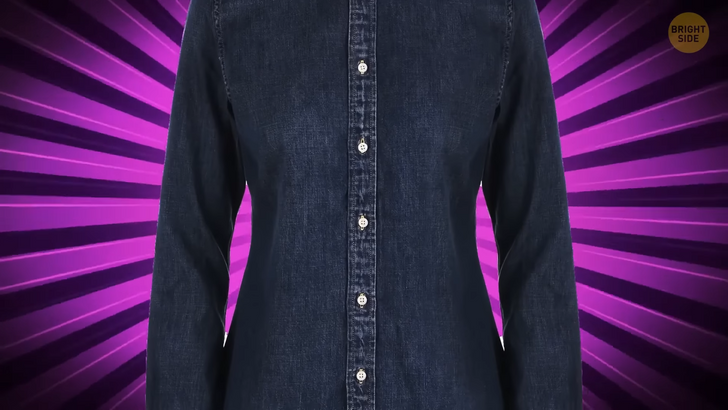I Can’t Believe What My Ex-Husband Asked Our Daughter to Do

Pockets are usually on the left side of shirts because most people are right-handed. Is this a myth or fact?

This is actually true! Many products favor the righties! Left-handed people will relate to this on so many levels. Let’s say public transport. Have you ever noticed that the scanner at stations is typically on the right side?
Household equipment and devices are one more example. Scissors, tweezers, bottle openers, and many other kitchen and household appliances are designed with right-handed people in mind. The same goes for shirt pockets. While some people use both hands equally and others change their hand preference between tasks, overall, most people are right-handed.
A study has revealed that 75% to 90% of the world’s population are right-handed, and 10% are left-handed. This means it’s more convenient for most people to have pockets on the left side than on the right side of their garments. Try it out for yourself. Your elbow kind of folds when you try to reach into the pocket on the right side. Whereas on the left side, your elbow makes an arc shape, which makes it easier to put things inside the pocket and take them out.
Eating more protein leads to having bigger muscles. What do you think about this, bodybuilders? Myth or fact?
This is a myth. It’s true that eating protein is essential for building bigger muscles. I mean, proteins are the building blocks of your body! And yet, eating more than you need is unnecessary.

Everyone should drink 8 glasses of water a day. Do you think this is a myth or fact?
This is a myth. So, don’t blame yourself for drinking “less” water than recommended. Eight glasses are not a magic number. Hydration needs differ from one person to another.
How much water you should drink every day depends on your activity and exercise level. The temperature of the place where you live affects this number too. If you live in a hot area, you sweat more and need to drink more water. Soup, coffee, tea, fruits, and other things you eat daily also contain water.
Carrots are high in sugar, so you should avoid eating them. If this is true, we should warn bunnies! Any guesses? Fact or myth?
It’s a myth. Carrots are about 85% water. 1 pound of cooked carrots only contains 3 teaspoons of sugar. Compared to the amount of sugar in desserts, this is nothing. Plus, carrots are high in phytochemicals, and eating them can help lower blood sugar.
Medieval people believed in the flat Earth. Is this a myth or fact?
Obviously, flat Earth is a myth, but so is the history built around this myth. You can’t say that at those times, the WHOLE world was skeptical about Earth’s spherical shape. Even everyday visible things proved that. For example, medieval people could see that the twilight glow during sunrise and sunset formed an arc over the horizon.

Vikings wore horned helmets. Is it a myth or fact?
The well-known image of a Viking warrior is almost always completed with a horned helmet. But in reality... there were no horns! There’s no evidence that Viking helmets were horned.
Detox juices cleanse your body. Is it a fact or myth?
It’s a myth. Detoxification doesn’t work that way. Your internal organs are responsible for the process of cleansing — the spleen, liver, kidneys... Especially the liver! Your body is always in a natural state of cleansing itself. A person doesn’t need to drink juices for detoxification.
Nuts are junk food. Any thoughts? Myth or fact?
You’re right. This is a myth. Nuts are full of healthy fats. They are good for your heart and other organs
The average American throws away about 82 pounds of textile waste per year. Is this a fact or myth?
Fact! Imagine all that waste! When someone throws their clothes away, they don’t disappear into thin air. These items most likely reach landfills as their final destination. Donating clothes and selling them in second-hand stores are much better options.
Now, you’ve probably heard about “life-saving laundry tricks” that are said to make your clothes super clean and as good as they were on day one. What if those laundry tips are actually myths? I have 3 of them lined up for you.

Shirts should be buttoned when you put them in the laundry. Is it true or not?
This is a myth. You’d better keep ZIPPERS closed to keep their teeth from catching the fabric of other clothes. But fastening the buttons of a shirt can expand the button net and the buttonhole. In the long term, buttons will start slipping out of place.
Washing clothes in hot water is the most effective way to clean them. Is this a myth or fact?
That’s another laundry myth. You want to rid your clothes of germs. Yet, hot water alone won’t be enough for this. Nowadays, many detergents can clean clothes in cold or warm water.
You should remove stains from the face of the fabric. Is it true?
Most people apply water and soap to the stain, starting from the front side of the fabric. But that’s not the best option. A much better way is to start from the back. The stain can go deeper if you treat it from the front. Try to make the stain move up to the surface rather than push it inside.
Listening to music is an effective tool for learning languages. Is it a myth or fact?
It’s a fact! Scientists say listening to a song and humming along can help you learn a language. Most people struggle to learn grammar. Yet, in our daily lives, we don’t always follow grammar rules. Songs can help you pick up informal expressions.
Scientists have also concluded that music can help you remember new words and add them to your vocabulary. Let me give you an example — it’s from your first year at school. Yep, the alphabet song!

Are you a morning person or a night owl? Either way, you might want to know these facts and myths about sleep.
The longest someone went without sleep was 11 days. Do you think this is possible, or is it an urban legend?
This is a fact. Randy Gardner set the record for the longest amount of time a person went without sleep. It was an experiment carried out by Stanford sleep researcher Dr. William C. Dement. The doctor recorded and monitored Randy Gardner’s sleep activity. Gardner managed to stay awake for 11 days and 25 minutes!
Your body eventually gets used to getting less sleep. Myth or fact?
It’s a myth. There are many studies proving that your body, and especially your brain, can’t get used to sleeping less. Have you noticed that after a few nights of insufficient sleep, you begin to feel groggier during the day? That’s your body trying to adjust to not getting enough rest. Long-term sleep deprivation affects your daytime performance, focus, and decision-making.
Many grown-ups need five or fewer hours of sleep. Can it be true?
Well, this one’s easy — it’s a myth. Experts from the National Sleep Foundation recommend that the average adult sleeps 7 to 9 hours per night. Some people have a genetic mutation thanks to which they wake up refreshed after a short night’s sleep. But such people are an exception — one in 4 million.
The ability to fall asleep in any place and at any time means you’re a “good sleeper.” What do you think, myth or fact?
It’s a myth! A good sleeper gets a proper amount of sleep and has a regular sleep schedule.
Cats spend two-thirds of their life asleep. Do you believe that?
This will probably come as no surprise. It’s a fact!











